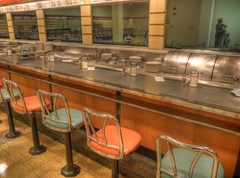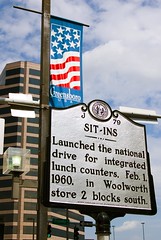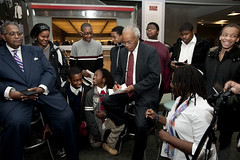Civil Rights Sit-Ins
"Sitting Down for a Cup of Coffee and Civil Rights"
by Nancie McDermott
Reprinted with permission from the Tar Heel Junior Historian. Spring 2007.
Tar Heel Junior Historian Association, NC Museum of History
A hot dog got it all started—the hot dog that Joe McNeil did not get to eat one day in January 1960. Nineteen years old and a graduate of Williston High School in Wilmington, McNeil was a student at what is now North Carolina A&T State University, a historically black college in Greensboro.
The young man had spent Christmas vacation visiting family in New York, and he had returned to Greensboro via a Greyhound bus. Feeling hungry after the long ride, McNeil stopped by the bus station café to order a hot dog. Refused service because he was black, he arrived at his dormitory still hungry and angry over the injustice that African American citizens faced daily. Black people could work in restaurants preparing food but could not sit down and be served at most of them. They could spend money in stores but couldn’t drink from water fountains or use restrooms set aside for white customers. Racial segregation had been legal and enforced throughout the American South for more than fifty years.
Segregation meant that businesses, government offices, schools, and other public places could turn away people simply based on race. The system of segregation denied nonwhite Americans basic rights to eat, travel, work, and live freely.
McNeil went to his dormitory room on the second floor of Scott Hall and told his roommate Ezell Blair Jr. (now Jabreel Khazan) what had happened. They talked things over with David Richmond and Frank McCain, two friends who lived down the hall. The four young men had often discussed segregation and what they might do to change the system. That night, they decided to take action on behalf of civil rights.
The next afternoon, February 1, 1960, the four met in front of Bluford Library on the college campus. They walked two miles to the F. W. Woolworth store on Elm Street in downtown Greensboro. As planned, the students bought tubes of toothpaste and kept the receipts, to show that they were customers of the store. They then walked to the Woolworth’s lunch counter and took seats. All four requested cups of coffee. The waitress refused to serve them, and the store manager asked them to leave. They politely and quietly stayed put.
The store closed early tha t day, and the four young men hurried back to campus to tell friends what they had done and to ask for help. The next day they returned to the lunch counter, with several fellow students. The peaceful campaign for the right to eat in a public restaurant became front- page news. Community leaders, including ministers from African American churches, members of the local chapter of the National Association for the Advancement of Colored People (NAACP), and college administrators and professors, met with the students. They encouraged them to keep up their quiet protest.
t day, and the four young men hurried back to campus to tell friends what they had done and to ask for help. The next day they returned to the lunch counter, with several fellow students. The peaceful campaign for the right to eat in a public restaurant became front- page news. Community leaders, including ministers from African American churches, members of the local chapter of the National Association for the Advancement of Colored People (NAACP), and college administrators and professors, met with the students. They encouraged them to keep up their quiet protest.
By Wednesday, February 3, more than sixty young people had joined the sit-ins, including students from two more historically black educational institutions in Greensboro: Dudley High School and Bennett College for Women. On Thursday three white students from Woman’s College (now the University of North Carolina at Greensboro) joined the group. Students began taking turns sitting at the lunch counter. Meanwhile, sit-ins had begun down the street at the S. H. Kress store’s lunch counter.
Television coverage carried the news around the country. Within a few days, lunch counter sit-ins took place in towns across North Carolina, including High Point, Salisbury, Shelby, New Bern, Elizabeth City, Concord, Monroe, Rutherfordton, Henderson, and Raleigh. Young people soon carried the peaceful demand for restaurant service beyond North Carolina’s borders to cities throughout the South, including Richmond, Baltimore, Nashville, and Montgomery. When the college semester ended in May, the Dudley High students continued the Greensboro sit-ins.
After six months of lunch counter protests throughout the South, the Woolworth chain’s management in New York City decided its stores would begin serving food to everyone. In July three store employees became the first African American customers to eat at the Greensboro Woolworth’s lunch counter. One was twenty-eight-year-old Geneva Tisdale. She had been cooking in the store’s kitchen for several years. Tisdale ordered a sandwich made with the egg salad she herself had mixed together earlier that morning.
McNeil, Blair, Richmond, and McCain returned to A&T in the fall. They felt proud of having inspired a movement that awakened many people to the cause of civil rights. Racial segregation in restaurants soon ended in North Carolina. The right to buy a hot dog, drink from a water fountain, or sit down for a cup of coffee and a piece of pie was becoming part of everyday life for African Americans throughout the South.
*At the time of this article’s publication, Nancie McDermott was a food writer and cooking teacher who had recently released the cookbook Southern Cakes. Born in Burlington, raised in High Point, and a graduate of the University of North Carolina at Chapel Hill, she is a former middle school language arts and social studies teacher. She is a member of the Southern Foodways Alliance and a resident of Chapel Hill.
Additional Resources:
SmithsonianMag, Courage at the Greensboro Lunch Counter: http://www.smithsonianmag.com/arts-culture/Courage-at-the-Greensboro-Lun...
Smithsonian Institute, Woolworth's Lunch Counter: http://americanhistory.si.edu/brown/history/6-legacy/freedom-struggle-2....
NPR, The Woolworth Sit-In That Launched a Movement: http://www.npr.org/templates/story/story.php?storyId=18615556
Greensboro Sit-Ins: http://www.sitins.com/index.shtml
History Channel: http://www.history.com/topics/black-history/the-greensboro-sit-in
UNCG Library, Civil Rights Greensboro: http://library.uncg.edu/dp/crg/topicalessays/busdesegsitins.aspx
The Greensboro sit-ins. ANCHOR: https://www.ncpedia.org/anchor/greensboro-sit-ins
The Civil Rights Movement, 1960-1980 .ANCHOR: https://www.ncpedia.org/anchor/civil-rights-movement-1960
International Civil Rights Center & Museum, The Greensboro Chronology: http://www.sitinmovement.org/history/greensboro-chronology.asp
Image and Video Credits:
Clay, Charlie. September 28, 2006."Woolworth Sit-Ins." Located at https://www.flickr.com/photos/emosubaru/255370001/. Accessed February 27, 2012.
National Museum of American History.February 2010. "Youth Meet the Greensboro Four."Located at https://www.flickr.com/photos/nationalmuseumofamericanhistory/5303499969/ Accessed February 27, 2012.
Tony, Jason. November, 2009. "F.W. Woolworth Co.". Located at https://www.flickr.com/photos/misterjt/4132943183/. Accessed February 27, 2012.
Dibona, Frank. September 10, 2011. "Woolworths Greensboro." Located at https://www.flickr.com/photos/kiddocone/6143681020/. Accessed February 27, 2012.
Mulitalento, History Channel. August 30, 2011. Located at http://www.youtube.com/watch?v=96PKWL1b9gs. Accessed February 27, 2012.
1 January 2007 | McDermott, Nancie


